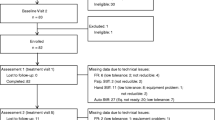Abstract
Three years ago, an 18-month randomized controlled trial of chronic, nonspecific low back pain investigated the effectiveness of instructing subjects to restrict bending activities in the early morning, when the fluid content in the disc is increased. Pain days (as recorded by daily diaries) were reduced 23% in the treatment group, compared to a 2% reduction in the control (sham treatment) group. The purpose of the current follow-up study was to determine whether the results of that trial were maintained during the 3 years following completion of the trial. A questionnaire was mailed to the 60 subjects who completed the original trial. Fifty subjects completed the questionnaire for a response rate of 83%. Thirty-one subjects (62%) continued to restrict bending activities in the early morning, and experienced a further reduction of 10.1 pain days per month (51%) since the completion of the experiment. However, some of the subjects who did not continue to comply also improved. Several possible explanations for the improvement of noncompliant subjects are offered.
Similar content being viewed by others
REFERENCES
Race A, Broom ND, Robertson P. Effect of loading rate and hydration on the mechanical properties of the disc. Spine 2000; 25: 662-669.
Simunic DI, Broom ND, Robertson PA. Biomechanical factors influencing nuclear disruption of the intervertebral disc. Spine 2001; 26: 1223-1230.
Adams MA, Dolan P, Hutton WC. Diurnal variations in the stresses on the lumbar spine. Spine 1987; 12: 130-137.
Adams MA, Dolan P, Hutton WC, Porter RW. Diurnal changes in spinal mechanics and their clinical significance. J Bone Joint Surg Br 1990; 72B: 266-270.
Snook SH, Webster BS, McGorry RW, Fogleman MT, McCann KB. The reduction of chronic nonspecific low back pain through the control of early morning lumbar flexion: A randomized controlled trial. Spine 1998; 23: 2601-2607.
Faas A, Chavannes AW, van Eijk JThM, Gubbels JW. A randomized, placebo-controlled trial of exercise therapy in patients with acute low back pain. Spine 1993; 18: 1388-1395.
McGorry RW, Webster BS, Snook SH. Accuracy of pain recall in chronic and recurrent low back pain. J Occup Rehabil 1999; 9: 169-178.
Von Korff M, Deyo RA, Cherkin D, Barlow W. Back pain in primary care: Outcomes at 1 year. Spine 1993; 18: 855-862.
Weinstein JN. Letters: Clinical crossroads: A 45-year old man with low back pain. JAMA 1999; 281: 893-895.
Author information
Authors and Affiliations
Corresponding author
Rights and permissions
About this article
Cite this article
Snook, S.H., Webster, B.S. & McGorry, R.W. The Reduction of Chronic, Nonspecific Low Back Pain Through the Control of Early Morning Lumbar Flexion: 3-Year Follow-Up. J Occup Rehabil 12, 13–19 (2002). https://doi.org/10.1023/A:1013542119063
Issue Date:
DOI: https://doi.org/10.1023/A:1013542119063




